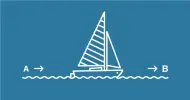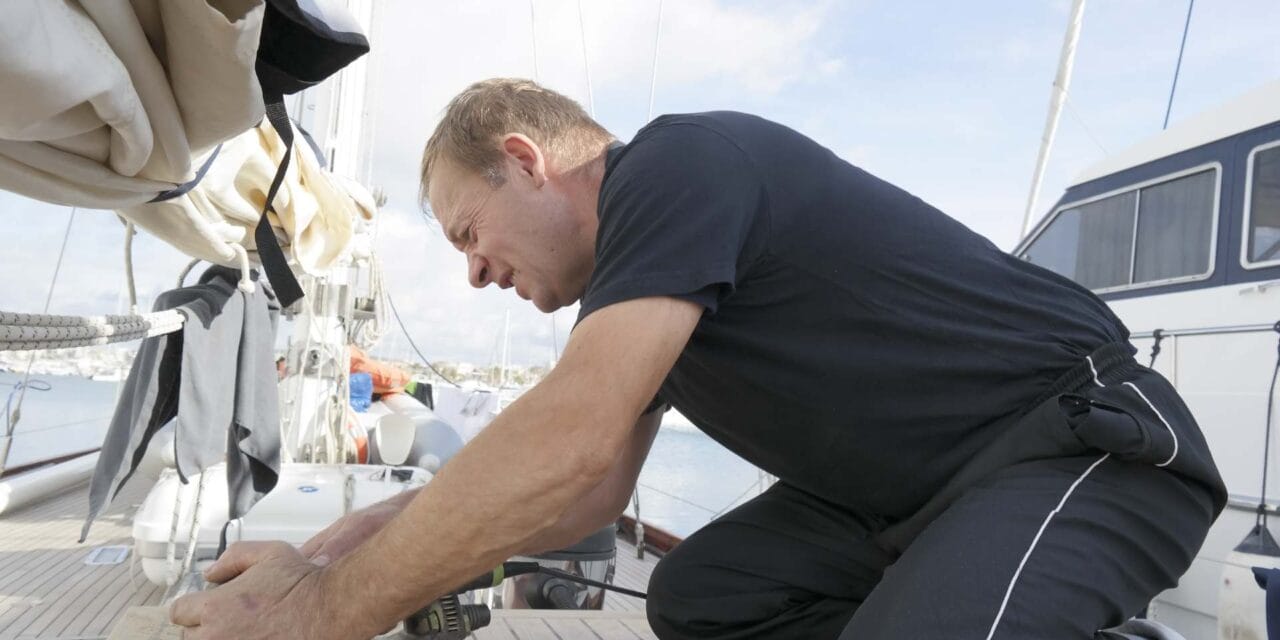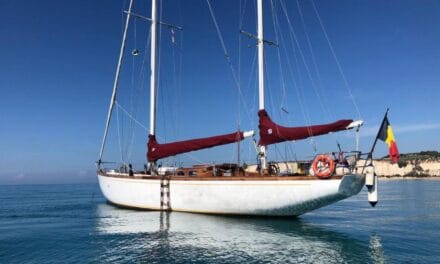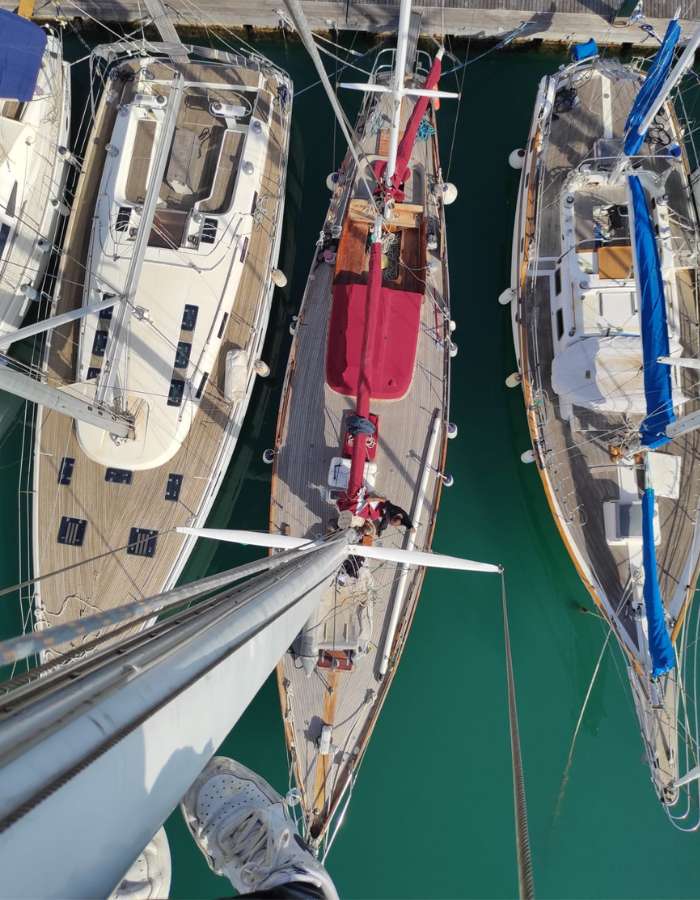How to Prepare Yacht for Ocean Crossing
Preparing your sailboat for an ocean crossing requires precise timing and thorough preparation. Start by researching historical weather data and aligning your departure with favorable winds, avoiding hurricane seasons. Inspect and replace worn rigging, make certain all electronics and sails are operational, and efficiently organize storage. Invest in all-encompassing insurance covering damage, theft, and medical emergencies. Equip your boat with essential safety gear, a well-stocked first-aid kit, and reliable communication systems like VHF and HF radios. Calculate water needs, invest in desalination units, and pack a mix of durable and perishable foods. Understanding these key steps will set the stage for a successful voyage.
When and how to Cross Ocean Sailing Route
Understanding the best timing and routes for crossing oceans is vital for a successful voyage.
You’ll need to take into account seasonal weather patterns, particularly for sailing across the Atlantic, and decide whether to join a rally or undertake the journey solo.
This section will guide you through the critical aspects to increase your chances for a safe and efficient passage.
Remember – if are feeling not comfortable for first time crossing hire one of our skippers or order an yacht delivery service.
When to cross Oceans?
Timing your ocean crossing is essential, as weather patterns and seasonal changes can greatly impact the safety and efficiency of your journey. When preparing to cross an ocean, understanding global weather patterns is paramount.
For your sailing voyage, research historical weather data and consult seasoned sailors who’ve successfully navigated the route you’re planning. Knowing when to cross oceans involves aligning your departure with favorable wind conditions and avoiding hurricane seasons.
This preparation guarantees a smoother passage across an ocean. Utilize technology like weather-routing software to plan your trip accurately. By choosing the best time to set sail, you’ll not only enhance safety but also foster a sense of belonging within the sailing community, united by shared experiences and wisdom.
Seasons and routes to sail across the Ocean
To successfully navigate the Atlantic, it’s vital to meticulously plan your departure around the prevailing trade winds and favorable weather windows. For the Atlantic circuit, many sailors begin their journey in the Canary Islands or Cape Verde.
The best time for long-distance sailing across the Atlantic is typically late November to early December.
Here are three important considerations for your route:
- Trade Winds: Leverage the northeast trade winds for a smoother passage.
- Departure Points: The Canary Islands and Cape Verde are popular starting points for offshore sailing.
- Hurricane, Cyclones and Typhoons Season: Avoid the Atlantic hurricane season, which runs from June to November.

Join rally or sail alone
Have you considered whether joining a rally or sailing alone best suits your ocean crossing ambitions?
Participating in the ARC Rally offers camaraderie, shared knowledge, and coordinated safety measures. You’ll benefit from a structured environment and the collective expertise of fellow sailors, enhancing your experience and safety.
On the other hand, choosing to sail alone grants you complete autonomy and the freedom to set your own schedule. However, it requires meticulous planning of safety equipment and provisions, as you’ll be solely responsible for every aspect of the journey.
Both options have their merits. Joining the ARC Rally can provide a sense of community, while sailing alone allows for a personalized adventure. Your decision should align with your preferences and experience level. In both options it’s ideal way for Miles Building and to gain sailing experience.
Check the state of the boat
Before setting out on your ocean crossing, you’ll need to meticulously examine the state of your boat to guarantee its seaworthiness. Start by inspecting the rigging for any signs of wear or weakness, and make sure you have the appropriate sails, including spares.
Don’t forget to prepare your electronics, organize storage efficiently, and check your fishing equipment to maximize self-sufficiency at sea.
Rigging
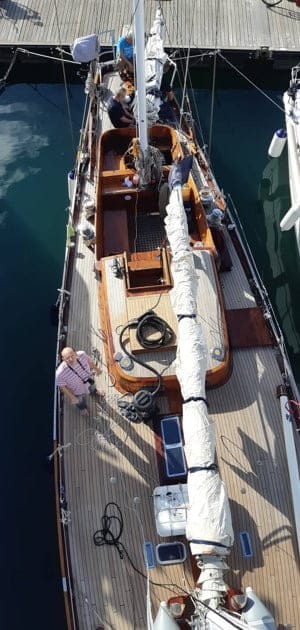
Ensuring the integrity of your sailboat’s rigging is of utmost importance, as a compromised mast not only jeopardizes your ability to sail but also disrupts essential communications by disabling the radio antenna. Begin your check with the running rigging; inspect all lines, halyards, and sheets for wear. Whether you’re sailing upwind or deploying the spinnaker downwind, reliable rigging is vital.
Next, examine the standing rigging:
- Mast and Spars: Check for any signs of corrosion or fatigue. Look for any signs of bending, cracking, or loose fittings. Check the mast step for any movement or wear. Pay attention to the masthead fittings, including sheaves, lights, and antennas, to ensure everything is secure.
- Turnbuckles and Terminals: Make sure these are secure and free of rust.
- Wire Rigging : Inspect all wire rigging (shrouds, stays) for signs of corrosion, cracks, broken strands, or damage to the swages (fittings)
- Chainplates: Inspect chainplates (where the rigging attaches to the hull) for any cracks, corrosion, or movement
- Examine all attachment points on the mast, boom, and deck for any cracks or corrosion
- It is essential to conduct a thorough rigging inspection regularly to ensure the safety and integrity of your sailboat. If you notice any issues during your check, do not hesitate to address them promptly to prevent any potential problems while out on the water. Remember, a well-maintained rigging system is crucial for safe and enjoyable sailing experiences.
Choose right sails and take some spare ones
Selecting the appropriate sails for an ocean crossing is a critical aspect of preparation, demanding thorough inspection and consideration of both sail type and condition. Your sailing adventure hinges on durable and versatile sails, so evaluate their material and stitching meticulously. For bluewater cruising, you’ll need a robust mainsail and a variety of foresails, including a genoa and staysail. Always carry spare parts and extra sails like a storm jib and an additional mainsail.
| Sail Type | Primary Use | Spare Parts Needed |
| Mainsail | General sailing | Extra battens |
| Genoa | Light wind sailing | Repair tape |
| Storm Jib | Heavy weather | Spare hanks |
Prioritizing the right sails guarantees a smoother, safer sailing trip.
Prepare your electronics
After guaranteeing your sails are in top condition, turn your attention to the boat’s electronics to secure reliable navigation and communication throughout your ocean crossing.
Check every component of your communication systems and electrical systems to ensure they’re functioning at their best. Here’s a checklist to help:
- Radios and Satellite Phone: Verify that all radios and your satellite phone are operational and have updated software. Test their range and clarity.
- Power Sources: Inspect the batteries and chargers. Ensure they’re fully charged and capable of holding a charge over long durations.
- Navigation Equipment: Update charts on your navigation plotter and ensure any laptops or tablets used for navigation have the necessary software and backups.
Organising storage on the boat
Properly organising storage on your sailboat is crucial to guarantee safety and efficiency during your ocean crossing.
Start by placing non-perishable items like cans near the bilge, making sure they’re securely packed to prevent movement. Opt for plastic cans over metal to avoid rust and leaks.
For fresh produce, fruits can be stored in the dinghy under a shaded area to keep them cool and preserve their freshness. Make sure all stored items are in super dry places and use extra sealant packing to protect against moisture.
Avoid glass packaging as it can shatter in rough seas. By meticulously planning your storage, you’ll maintain a well-balanced vessel and have everything you need within easy reach, enhancing your sailing experience.
Fishing equipment
Guaranteeing that your fishing equipment is in top condition before setting off is crucial for both safety and the opportunity to enjoy fresh seafood during your voyage. Properly maintained gear can make all the difference when you’re sailing across the ocean.
Here are three critical steps to prepare your fishing equipment:
- Inspect and Test Rods and Reels: Verify that your rods and reels are fully functional and free of corrosion. Replace any damaged parts.
- Stock Up on Tackle: Make sure you have a variety of lures, hooks, and lines suitable for oceanic fishing.
- Prepare Storage: Organize your fishing gear in accessible, secure compartments to minimize the risk of damage or loss during rough seas.
With these steps, you’ll be well-prepared for a successful fishing experience and fresh sushi, even if seasickness strikes.
Be insured – Offshore boat and sailing crew insurance
Securing thorough offshore boat and sailing crew insurance is an important step in safeguarding your investment and guaranteeing the safety of everyone on board during an ocean crossing. Boat insurance protects your vessel against damage, theft, and unforeseen circumstances, while sailing crew insurance covers medical emergencies and accidents. When you’re out on the open ocean, it’s vital to be insured to mitigate risks and enjoy peace of mind.
| Insurance Type | Coverage Includes | Why It Matters |
| Boat Insurance | Damage/Theft | Protects your investment at destination |
| Sailing Crew Insurance | Medical Emergencies | Secures crew safety |
| Offshore Coverage | Extended Range | Necessary for ocean crossing |
| Liability Insurance | Third-Party Claims | Covers legal responsibilities |
| Personal Belongings | Crew’s Gear | Protects personal items |
Preparing the Sailing Crew to Cross an Ocean
When preparing your sailing crew for an ocean crossing, it’s essential to meticulously plan your provisions.
Always carry more water than you think you’ll need, and make sure you have ample vegetables, fruits, and protein to sustain the crew.
In addition, stock up on non-perishable food basics and select perishables that are suitable for blue water sailing.
Always take More Water Than You Think You Need
To guarantee a successful ocean sailing adventure, it’s crucial to carry at least one-third to half more water than you think you’ll need, as unexpected delays can greatly extend your time at sea. When you’re bluewater sailing, the significance of adequate water can’t be overstated. Covering thousands of nautical miles means you must prepare for unforeseen circumstances. Prioritize safety gear, but water is your most critical supply.
Consider these key actions:
- Calculate Needs: Estimate daily consumption per crew member and multiply by the voyage length, then add 50%.
- Storage Solutions: Invest in high-quality, space-efficient containers to maximize your storage capacity.
- Watermakers: Equip your vessel with a reliable desalination unit as a backup.
Being prepared guarantees your crew’s survival and peace of mind during your ocean sailing adventure.
Provision Vegetables, Fruits and Protein for an Ocean Crossing
Provisioning your sailboat with an ample supply of fresh vegetables, fruits, and protein is essential for maintaining the crew’s health and morale on an extended ocean crossing. To ensure your provisions last, pack a mix of long-lasting items and those to be consumed first. Store root vegetables like carrots and potatoes in cool, dry areas. For fruits, prioritize durable options such as apples and citrus. Protein sources like canned fish, vacuum-sealed meats, and dried legumes should be stored securely to prevent spoilage.
| Vegetables | Fruits | Protein |
| Carrots | Apples | Canned Fish |
| Potatoes | Citrus Fruits | Vacuum-Sealed Meats |
| Onions | Bananas* | Dried Legumes |
| Bell Peppers* | Tomatoes* | Nuts and Seeds |
*Consume first
Non-Perishable Food Basics for your passage
To guarantee the sailing crew remains well-nourished and energized throughout an ocean crossing, focus on stocking a variety of non-perishable food staples that offer both convenience and nutritional value. Effective preparation guarantees your voyage is smooth and enjoyable.
Incorporate these essentials:
- Canned Goods: Opt for a variety of vegetables, beans, and meats. They’re durable and packed with nutrients.
- Dried Foods: Items like pasta, rice, and lentils provide a foundation for hearty meals. They’re lightweight and easy to store.
- Snacks and Supplements: Energy bars, nuts, and dried fruits are quick sources of energy and valuable nutrients.
Perishables for blue water sailing
Maintaining a supply of fresh perishables such as fruits, vegetables, and dairy products is essential for guaranteeing a balanced diet during your ocean crossing. Effective meal planning and strategic food storage are vital. Prioritize provisions that offer nutritional value and longevity. Invest in reliable refrigeration to keep perishables fresh. Rotate your stock to minimize waste and optimize space. Here’s a breakdown of key perishables and storage tips:
| Perishable | Storage Method |
| Apples | Cool, dry storage or shaded dinghy |
| Carrots | Refrigeration |
| Leafy Greens | Damp cloth in refrigerator |
| Cheese | Wrapped, refrigerated |
| Eggs | Carton, cool area |
| Water | Plastic, originally closed tanks and bottles |
Proper planning ensures your crew stays nourished and ready for the challenges of blue water sailing.
Be Prepared for Emergencies at Sea
When getting ready for an ocean crossing, you can’t overstate the importance of thorough safety equipment and a wide inventory of spare parts. Make sure your sailboat is stocked with life rafts, EPIRBs, and medical kits.
Carry spares for critical components like the engine, rigging, and electronics. This preparation will greatly enhance your ability to handle emergencies at sea with confidence and efficiency.
Safety Equipment
When getting ready for an ocean crossing, you can’t afford to neglect essential safety equipment. Make sure your sailboat is equipped with:
- A high-quality life raft
- Reliable lifejackets
- Emergency beacons
Additionally, stock a thorough first-aid kit with necessary medications and remedies for seasickness.
LifeRaft
For an ocean crossing, it’s crucial to equip your sailboat with a certified oceanic liferaft, designed to sustain you with adequate food and water supplies for extended periods far from immediate rescue assistance.
Make sure your liferaft meets the following criteria:
- Certified for ocean passages: Built for long journeys.
- Equipped for sea survival: Includes necessary survival gear.
- Adapted for remote sailing routes: Reliable far from help. Give you an extra time to survive.
Lifejackets
Ensuring your sailboat is equipped with properly certified oceanic lifejackets is essential for maximizing survival chances in emergency situations.
These specialized lifejackets are designed to keep you afloat longer in the challenging oceanic waves.
Make sure your crew is well-versed in using this safety gear, even with their eyes closed.
Proper crew training can make all the difference in a man overboard scenario.
Beacons
In addition to lifejackets, equipping your sailboat with emergency beacons like EPIRBs (Emergency Position Indicating Radio Beacons) and PLBs (Personal Locator Beacons) guarantees that rescue services can locate you swiftly in a crisis situation.
- Install an EPIRB for automatic distress signals.
- Use Garmin InReach for two-way satellite communication.
- Integrate Iridium Go with SSB and HAM radio for extensive coverage.
EPIRB is a very useful device. However, don’t expect that after sending the signal, rescuers will start looking for you in the middle of the ocean. Too many of these devices fall into the water accidentally or are activated unintentionally. And the rescue operation costs a fortune.
Medications and First-Aid Supplies
Stocking your sailboat with a diverse array of medications and first-aid supplies is crucial to handling medical emergencies during an ocean crossing.
Make sure your first aid kit is thorough, covering everything from wound care to antibiotics. Train each crew member on its use and recognize the significance of medications specific to an ocean passage.
This preparedness allows you to make repairs swiftly and safely.
Prepare for seasickness
To mitigate the debilitating effects of seasickness, equip your sailboat with anti-nausea medications, wristbands, and acupressure techniques, making certain each crew member understands their proper usage.
Proper preparation can make an ocean crossing far more comfortable. Here’s what to take into account:
- Anti-nausea medications: Guarantee a variety for different needs.
- Wristbands: Effective for mild to moderate symptoms.
- Acupressure techniques: Teach and practice beforehand.
Emergency tilers
Ensuring your sailboat is equipped with an emergency tiller is equally important for maintaining control during unexpected steering failures. Whether you lose hydraulic fluid in your hydraulic steering system or your steering chain breaks, an emergency tiller will be your lifeline.
Prepare and store it securely, as losing it could leave you vulnerable at sea.
Check how it works and how connect your tiller. Sometimes you need a special screw or a pin. One time, when I sailed Vagabond in Atlantic, I had to use a spare tiller which was made by few pipes that ran through a special place on the deck, a bed in the stern room, a pile of boxes and mattresses collected there, up to the bilge which also contained canned goods. Good lesson.
Carry More Spares for the Boat
Your vessel’s reliability hinges on having an ample supply of spare parts, ensuring you can tackle any mechanical or technical failure during your ocean crossing.
Successful ocean cruising requires you to be prepared for the unexpected, turning your adventure of a lifetime into a safe and enjoyable journey across the ocean.
Equip your cruising yacht with essential spares to maintain operational integrity.
Here’s a list of critical spares to carry:
- Engine Parts: Spare belts, filters, and impellers. Also filter wrench and both, inch / metric wrenches
- Electrical Components: Fuses, bulbs, spare batteries, electric meter, some wires
- Rigging Gear: Extra lines, shackles, and blocks. Important – emergency rigging cutter in case of dismasting.
- Wrenches – take both, metric and inch (Imperial) ones. You can have inch engine screws and other stuff in metric system
Preparing the Sailing Crew to Cross an Ocean
To guarantee a successful ocean crossing, you’ll need to focus on effective communication, fostering teamwork, and optimizing the living space aboard.
It’s essential to prepare for the unique challenges of sailing with kids and to select appropriate offshore clothing to withstand varied weather conditions.
Each of these elements is crucial for maintaining morale and safety during your voyage.
Communication Onboard a Sailing Vessel for a Cross-Atlantic Voyage
Effective communication onboard is essential for guaranteeing the safety and efficiency of your crew during a cross-Atlantic voyage. Whether you’re participating in the Atlantic Rally for Cruisers or setting sail independently, robust comms are non-negotiable. Here are key points to take into account:
- Night Watch Coordination: Establish clear protocols for night watch shifts. Use handheld radios to maintain vigilance and relay critical information.
- Routing Updates: Regularly update your crew on routing and weather conditions. Utilize satellite communication systems for real-time data.
- Emergency Procedures: Ensure everyone knows emergency comms protocols. Practice man-overboard drills and use VHF radios for swift response.
- Lifejackets – everybody use them including captain all time on deck.
Prioritize these elements to maintain a cohesive and responsive crew throughout your journey.
The benefits of teamwork
In tandem with maintaining robust communication systems, fostering a spirit of teamwork is paramount for preparing your crew to cross an ocean efficiently and safely.
Teamwork guarantees each crew member understands their role and can seamlessly collaborate during the voyage. To prepare effectively, conduct regular drills focusing on emergency protocols, sail handling, and navigation.
Emphasize shared responsibilities and mutual support, as these elements are essential for a successful ocean crossing. A cohesive team can tackle challenges such as adverse weather and mechanical issues with greater ease.
Living Space Aboard a Boat
When preparing for an ocean crossing, optimizing the living space aboard your sailboat is essential for guaranteeing comfort and efficiency during the voyage. Properly preparing the living quarters can greatly impact the morale and well-being of your crew.
Here are three key advises:
- Space Utilization: Maximize every inch of available space. Install shelves, hooks, and storage nets to keep essentials organized and accessible.
- Comfort: Invest in high-quality bedding and seating. Comfortable sleeping and relaxation areas can make a substantial difference in long-term voyages.
- Safety and Accessibility: Ensure all safety equipment is easily accessible. Keep pathways clear to avoid accidents, and secure all loose items to prevent them from becoming hazards during rough seas.
These steps will help create a harmonious living space aboard a boat for your ocean crossing voyage.
Never, ever perform repairs that are not critical and involve even a minimal risk of injury to a crew member. For example, don’t replace the anchor light bulb because you don’t need it on the ocean. If your crew member falls or cuts his leg badly, no one will help him. So if you have ADHD, play cards or do the dishes
Sailing with the kids
Bringing children along for an ocean crossing demands meticulous planning and thorough preparation to guarantee their safety and comfort throughout the journey. Confirm the life raft is easily accessible and equipped with kid-friendly supplies.
Your electric battery should be reliable, powering essential systems and entertainment devices to keep kids engaged. As the skipper, establish clear safety protocols and rehearse emergency drills with the entire crew.
Before departing from Las Palmas, stock up on nutritious, kid-friendly provisions and involve them in the provisioning process. Create a structured daily routine to provide stability and a sense of normalcy.
Sailing with the kids can be an enriching family experience, but preparation is key to ensuring a smooth and enjoyable voyage for everyone.
Clothing recommendations for offshore sailing.
Equipping your crew with the right clothing for offshore sailing is essential to guarantee their comfort and safety in unpredictable ocean conditions. Proper preparation makes certain that everyone is ready for the rigors of a long voyage.
Focus on durable, high-quality gear designed specifically for offshore sailing. Here’s a detailed list to guide your clothing preparation:
- Foul Weather Gear: Invest in waterproof jackets and trousers that offer breathability and protection against harsh sea spray and rain.
- Layering System: Use moisture-wicking base layers, insulating mid-layers, and windproof outer layers to regulate body temperature effectively.
- Footwear: Choose non-slip, waterproof sailing boots to ensure secure footing and dry feet throughout the voyage.
With the right clothing, your crew will be well-prepared for any offshore challenge.
What not to take with you?
While guaranteeing your crew is outfitted with the right gear, it’s equally important to be discerning about what items to leave behind to maintain efficiency and safety on board.
Overpacking can become a hazard during an ocean crossing, so avoid bringing non-essentials. Personal electronics, unless waterproof and essential, should stay ashore to prevent damage and loss overboard.
Excessive clothing and bulky items can clutter your limited space, hindering movement. Leave behind non-essential tools and duplicate items; only the most critical, well-maintained tools should make the voyage.
For sailors, prioritizing necessary equipment over luxury or comfort items ensures a smoother, safer journey. Prepare wisely and remember, every item on board should serve a clear, functional purpose for your voyage.
Willpower and determination
Consistently fostering willpower and determination within your sailing crew is essential for a successful ocean crossing, as the mental fortitude to face prolonged isolation, unpredictable weather, and physical exhaustion can’t be underestimated. Preparation goes beyond physical readiness; mental resilience is vital.
Here are three key strategies:
- Mental Training Exercises: Engage in team-building activities and stress management workshops to build a robust psychological foundation.
- Simulated Voyages: Conduct shorter practice voyages to expose sailors to real-life challenges, enhancing their confidence and problem-solving skills.
- Open Communication: Foster a culture of transparency and support, encouraging crew members to share concerns and solutions openly.
Navigation and communication
When preparing for an ocean crossing, mastering both traditional and modern navigation techniques is essential.
You’ll need to be proficient in celestial navigation and equipped with the latest weather tools and satellite tracking systems, including Starlink.
Additionally, make sure you have reliable non-satellite communication methods as backups to maintain constant contact.
Celestial navigation
Mastering celestial navigation is essential for any sailor undertaking an ocean crossing, as it guarantees you can accurately determine your position using a sextant and astronomical tables. Mastery of this skill ensures you won’t rely solely on electronic systems.
To become proficient, focus on these key aspects:
- Sextant: Learn to use this precision instrument to measure the angle between celestial bodies and the horizon.
- Astronomic tables: Understand how to reference these tables for the necessary data to support your calculations.
- Calculation and plotting: Practice the calculations needed to convert sextant readings into a position, and accurately plot this on your chart.
Confidence in your celestial navigation abilities fosters a sense of belonging in the sailing community.
Weather tool
Accurate weather tools are indispensable for navigation and communication during an ocean crossing, ensuring you can anticipate and respond to changing conditions effectively.
When preparing for your voyage, invest in high-quality weather instruments like barometers, anemometers, and digital weather stations. These tools provide real-time data on atmospheric pressure and wind speed, essential for safe sailing.
Integrate software applications that offer detailed forecasts and storm tracking, enabling you to adjust your route proactively.
Don’t underestimate the value of a reliable VHF radio with weather channels for constant updates.
Satellite tracking
Incorporating satellite tracking systems such as Garmin and Spot-Gen into your sailboat’s navigation and communication toolkit enhances both safety and coordination during ocean crossings. These systems provide real-time location data and emergency communication capabilities, essential for long voyages. Here’s why you should integrate them:
- Real-time Tracking: Garmin and Spot-Gen offer continuous position updates, allowing you and your loved ones to monitor your sailboat’s progress.
- Emergency Alerts: Both systems include SOS functionality, ensuring immediate assistance if required.
- Communication: They enable two-way messaging, keeping you connected with support networks, even in remote areas.
Starlink
While satellite tracking systems like Garmin and Spot-Gen are invaluable, integrating Starlink for navigation and communication can further elevate your ocean-crossing experience by providing high-speed internet connectivity, even in the most remote areas.
This advanced system guarantees continuous access to real-time weather updates, essential for plotting your sailboat’s course during your voyage. Sailors often face isolation, but with Starlink, you can stay connected with loved ones and fellow sailors, fostering a sense of community and safety.
Its robust network minimizes the risk of communication blackouts, vital for emergency situations. By equipping your sailboat with Starlink, you’re not just enhancing navigational precision; you’re ensuring a smoother, more connected journey across the vast ocean.
Non-satellite communication
By utilizing traditional non-satellite communication tools, such as VHF and HF radios, you can guarantee you have reliable means of navigation and communication when sailing beyond the reach of satellite networks. These tools are indispensable for ensuring safety during your ocean crossing voyage.
To prepare effectively, make sure that:
- VHF Radio: Install a high-quality VHF radio for short-range communication, essential for contacting nearby vessels and coastal stations.
- HF Radio: Equip your sailboat with an HF radio for long-range communication, allowing you to reach out to distant stations and receive weather updates.
- Emergency Position Indicating Radio Beacon (EPIRB): Test and register your EPIRB, a crucial tool for signaling distress and ensuring rescue services can locate you quickly.
Frequently Asked Questions
What Type of Provisions Should Be Stocked for an Ocean Crossing Voyage?
Make sure you have non-perishable food, plenty of fresh water, and essential medical supplies. Don’t forget spare parts for your equipment and tools. Think of it as stocking a pantry for a long, unpredictable journey.
How Do You Manage Waste Disposal During Extended Periods at Sea?
You’ll need a waste management system, including biodegradable bags and a marine sanitation device. Make sure your holding tanks are regularly emptied at designated facilities. Never dispose of waste overboard; it’s essential for maintaining our shared marine environment.
What Kind of Medical Supplies Are Essential for an Ocean Crossing?
Oh, you’re planning an ocean crossing? Don’t forget an extensive first aid kit with seasickness meds, antibiotics, wound care supplies, and a satellite phone for emergencies. You’ll want to feel like a seasoned sailor, won’t you?
How Should You Prepare for Potential Wildlife Encounters, Like Whales or Sharks?
Confirm you’ve got a sturdy hull and secure all gear. Equip your sailboat with wildlife deterrents and sonar. Stay vigilant, keep a detailed log of sightings, and always respect marine life to guarantee safe, harmonious voyages.
What Steps Can Be Taken to Ensure the Mental Well-Being of the Crew?
To guarantee the crew’s mental well-being, foster camaraderie through team-building activities, regular communication, and shared responsibilities. Think of it as keeping the ship’s heart beating strong; a united crew is an unstoppable force.
